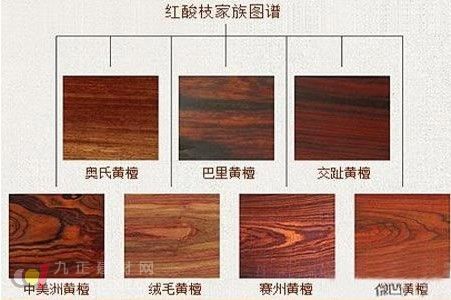As one of the key categories in the "Redwood" national standard, the red rosewood family encompasses several species, including Sian rosewood, A. sinensis, Diphong Dalbergia, Bari Dalbergia, Sai Dang, Sandalwood, and Central American Dalbergia. With seven distinct types, understanding how to differentiate between them can be quite challenging. This article dives into the various types of red rosewood, offering a comprehensive overview of this diverse wood family.
Red rosewood has become a popular choice for mahogany furniture due to its excellent quality, availability, and reasonable price. However, with so many variations within the red rosewood family, it's not always easy for consumers to tell the difference. The visual similarities between different species often lead to confusion, especially when prices vary only slightly.
Moreover, scientific identification methods typically require more than just wood samples. Without leaf specimens or additional data, determining the exact species can be difficult. As a result, relying on expert knowledge or basic identification techniques becomes essential for buyers looking to make informed decisions about their furniture purchases.

Wood Industry Information Network Data Map: Detailed Explanation of Red Rose Family Map
The "Redwood" national standard outlines specific criteria for defining red rosewood:
- It must belong to the genus Dalbergia.
- The wood structure should be fine to very fine, with an average tube hole chord diameter of no more than 200 μm.
- At a moisture content of 12%, the air-dry density should exceed 0.85 g/cm³.
- The heartwood should display a reddish-brown or purple-red color.
In addition, the standard describes the characteristics of red rosewood: it typically has a loose to semi-diffuse growth ring pattern, with a reddish-brown or purple-red heartwood. The axial thin wall tissue appears as concentric layers or narrow bands, and the wood is dense, with visible wave patterns. It also has a faint acidic scent, and most of the wood sinks in water. Radial surfaces often show distinctive stripe patterns due to interlaced textures.
By comparing these seven species, we can better understand the differences among them. First, all red rosewoods are part of the Dalbergia genus, which includes three main types: fragrant wood, black rosewood, and red rosewood. Among them, fragrant wood (Hainan huanghuali) is considered the most prestigious, while red rosewood is the most widely used in furniture production.
Secondly, in terms of popularity, Sian rosewood is the most sought after, followed by Diphong Dalbergia, A. sinensis, and Bari Dalbergia. In contrast, Saizhou Dalbergia, F. rosewood, and Central American Dalbergia are rarely used in China.
Thirdly, the primary sources of red rosewood are countries in Southeast Asia such as Laos, Myanmar, and Cambodia, as well as South America and Mexico. While some species like Dalbergia, A. serrata, and Bari Dalbergia are native to Southeast Asia, others originate from the Americas.
Fourth, historically, Cochin rosewood and Barry rosewood have been used in traditional Chinese furniture for centuries. Albright rosewood came next, followed by Diphong Dalbergia from the Americas.
Fifth, the color of red rosewood varies depending on its origin. Southeast Asian varieties like Cochin, Albright, and Barry rosewood tend to have a reddish-brown or purple-red hue. Meanwhile, species from South America and Mexico, such as Sian, F. rosewood, and Central American Dalbergia, often display a deeper red tone when freshly cut.
Finally, when considering air-dry density, Massachusetts rosewood has the highest at 1.20 g/cm³, surpassing other types like Barry, Cochin, and even A. sinensis in some cases.
Understanding these distinctions can help consumers make smarter choices when purchasing red rosewood furniture, ensuring they get the right product for their needs and budget.
Grille Daring Light,Recessed Led Grille Downlight, Aluminum Grille Light,Led Embedded Grille
FOSHAN CITY KURUI LIGHTING CO.,LTD , https://www.kuruilighting.com